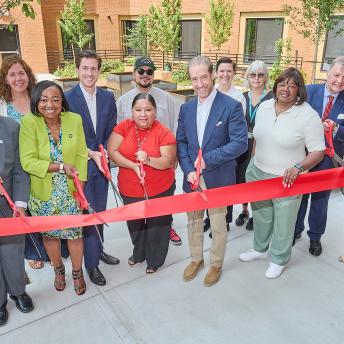NEW YORK, NY – The New York City Department of Housing Preservation and Development (HPD), along with city and state partners today launched a new assessment tool to better evaluate the physical, energy, and health opportunities of multifamily properties throughout New York City and New York State. The new tool, called the Integrated Physical Needs Assessment (IPNA), will be used by HPD, the New York City Housing Development Corporation (HDC), and the New York State Homes and Community Renewal (HCR) for projects receiving City and State financing to rehabilitate their buildings.
“Providing homes that are not just affordable, but quality, safe, and sustainable continues to be a City priority under Housing New York,” said HPD Commissioner Maria Torres-Springer. “This new assessment tool will ensure that health and energy efficiency are at the forefront as we work to evaluate building needs an opportunities. Thank you to our team at HPD and our partners across the city and state for their work to make this important tool a reality.”
“The new IPNA tool will make it easier and more efficient to assess the needs of our affordable housing properties, ultimately leading to healthier outcomes for the people of New York and a more sustainable City overall,” said HDC President Eric Enderlin. “Thanks to our teams at HPD, HDC, and all of our City, State, and private partners for their contributions towards creating this important tool.”
“This new tool will improve New York’s affordable housing by helping owners invest in cost-efficient energy, water, and health performance upgrades,” said Lindsay Robbins, senior advocate in the Urban Solutions program at the Natural Resources Defense Council. “That will cut New York’s carbon footprint, provide increased comfort for low-income families, and reduce operating and maintenance costs for building owners. That’s a big win all round that can serve as a model for affordable housing nationwide.”
The new IPNA tool builds upon the existing Green Physical Needs Assessment (GPNA), developed and released by HPD and HDC in early 2015, in an effort to integrate the evaluation of energy efficiency and water conservation opportunities to the standard Property Needs Assessment process. While an important step toward improving the sustainability of City-financed buildings, the City recognized untapped opportunities to align assessment methodologies across other City and State agencies and organizations to make the process of evaluating building needs and accessing financing or incentive resources much easier for owners. To access financing or incentives for rehabilitation and energy efficiency work, property owners need to complete a roof to cellar assessment of a building’s physical and energy needs. However, most affordable housing projects require multiple sources of financing, oftentimes from both City and State agencies, to make a project pencil out, and, currently, each agency requires owners to complete proprietary assessment tools in order to access their financing, adding significant costs and time, not to mention a duplication of efforts, to projects.
In December of 2015, under the leadership of the Energy Efficiency for All project - a partnership between the Natural Resources Defense Council (NRDC), National Housing Trust, Energy Foundation, and Elevate Energy - city and state affordable housing and environmental stakeholders were brought together to develop a comprehensive tool for integrated physical needs assessments and energy audits that would be accepted and utilized by multiple agencies.
RuthAnne Visnauskas, Commissioner of New York State Homes and Community Renewal said, “We are grateful to Energy Efficiency for All for coordinating the collaboration to implement this valuable tool which furthers Governor Cuomo's vision for sustainable development in New York State. This initiative shows that New York continues to lead the nation in this important effort to combat climate change and bring healthy and affordable housing to all New York families."
“Enterprise helped ensure that the new Integrated Physical Needs Assessment will make resident health a priority in every rehabilitation,” said Judi Kende, vice president and New York market leader, Enterprise Community Partners. “In order for people to reach their full potential, their homes must be healthy as well as affordable. We’re confident that with a specific focus on health, the new IPNA will make affordable homes in New York stronger and more sustainable in the long term. We are appreciative of the support of the New York State Health Foundation to do this work.”
This collaboration led to a new integrated approach to physical needs assessment that transcends the original mission of the working group to include a variety of critical new components:
- Health assessment to identify immediate health hazards and make recommendations for remediation and long-term health management practices;
- Solar assessment that evaluates a building’s potential to house a solar system on their roofs; and
- Streamlined process for owners to use the assessment to apply for sustainability incentives and to comply with other reporting requirements, from a variety of agencies/sources.
These components will allow for a more holistic and efficient approach to property needs assessment that can be used throughout the city and state. The tool will allow owners to best take advantage of incentives and opportunities to make their properties as sustainable, healthy, and safe as possible. Over the course of the coming year, the working group will continue to refine the IPNA to identify further opportunities for coordination and improvement.
The IPNA was made possible through the work of representatives from HPD, HDC, HCR, the New York City Department of Health (DoHMH), New York State Energy Research and Development Authority (NYSERDA), Con Edison, National Grid, Community Preservation Corporation (CPC), New York City Energy Efficiency Corporation (NYCEEC), Solar One, Enterprise Community Partners, Local Initiatives Support Corporation (LISC), New York City Mayor’s Office of Sustainability, New York Governor’s Office, and Taitem Engineering.
“There is an emerging consensus that low-income families suffer disproportionately from preventable health problems like asthma and obesity partly due to their housing conditions,” said Sam Marks, Executive Director of LISC New York City (LISC NYC). “The new Integrated Property Needs Assessment (IPNA) incorporates best practices from our Two Shades of Green (TSG) program which pioneered smart management strategies to create healthier affordable housing by improving water and energy efficiency and indoor air quality. We look forward to collaborating with HPD, DoHMH, and community partners to refine the IPNA as it becomes a widely used tool.”
The new IPNA tool is being launched amidst broader city initiatives aimed towards a more sustainable New York. At HPD, a variety of programs are used to ensure that the benefits of increased housing quality and lower utility costs improve the lives of affordable housing residents. The Enterprise Green Communities Criteria (EGCC) is a comprehensive green building framework for affordable housing and the only one of its kind. The Green Housing Preservation Program (GHPP) incentivizes energy efficiency improvements through forgivable no-interest loans. Healthy Homes NYC, run by the Department of Health and Mental Hygiene (DoHMH) for HPD projects, provides architects, contractors, and developers with training on healthy building practices. The Two Shades of Green Program (TSG) is a partnership between LISC New York City, the NYC Department of Health and Mental Hygiene, and several mission-driven developers of affordable housing that integrates green, healthy, and cost-effective measures into existing affordable housing rehabilitation. For more information on sustainability at HPD, visit the HPD website.
###
About the New York City Department of Housing Preservation and Development (HPD):
The New York City Department of Housing Preservation and Development (HPD) is the nation’s largest municipal housing preservation and development agency. Its mission is to promote quality housing and diverse, thriving neighborhoods for New Yorkers through loan and development programs for new affordable housing, preservation of the affordability of the existing housing stock, enforcement of housing quality standards, and educational programs for tenants and building owners. HPD is tasked with fulfilling Mayor de Blasio’s Housing New York: A Five-Borough Ten-Year Plan to create and preserve 200,000 affordable units for New Yorkers at the very lowest incomes to those in the middle class. For more information visit www.nyc.gov/hpd and for regular updates on HPD news and services, connect with us on Facebook, Twitter, and Instagram @NYCHousing.
The New York City Housing Development Corporation (HDC):
In 1971, the New York State Legislature created the New York City Housing Development Corporation (HDC) as a supplementary and alternative means of supplying financing for affordable housing that was independent from the City's capital budget. The flexibility built into HDC’s authorizing statute allows it to amend its programs and goals in response to the changing economic climate. As a result, HDC has become the leading local housing finance agency in the nation, outperforming many of the nation’s largest banks in the volume and dollar amount of bonds issued. Since 2014, HDC has leveraged more than $4.5 billion in bond financing and devoted more than $480 million in direct subsidy from its corporate reserves to support Mayor de Blasio’s housing plan.

